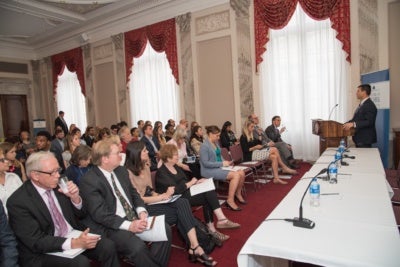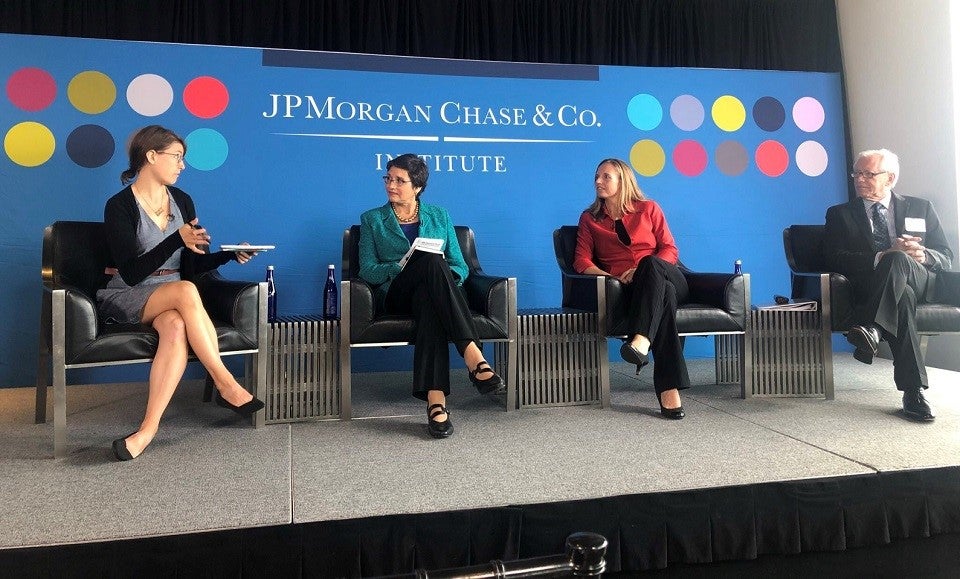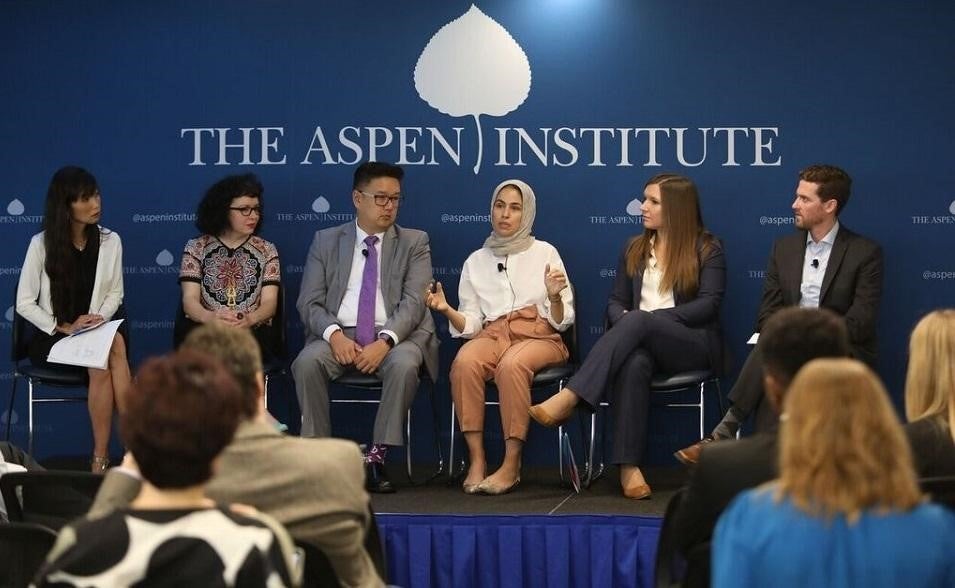As the year comes to a close, we are thankful for the support and interest we have received in examining how work is changing and what can be done to help workers and businesses meet the challenges of the 21st century. Throughout the year, we have focused on policy solutions to improve economic security for both traditional and independent workers, to expand investment in and access to effective education and training programs in response to increased automation, and to reduce pressures on businesses to focus on short-term profits over long-term value creation. We have highlighted how the economy is changing through events and collaborations with companies and organizations like the JPMorgan Chase Institute, Fidelity Labs and bSolo, WeWork, Cornell University’s ILR School, and X, the Moonshot Factory. The Future of Work Initiative National Advisory Council convened twice this year to help identify and implement innovative ideas to address the challenges and opportunities presented by the changing economy.
Below are some of our most notable developments of the past year. We hope you have a happy holiday season and we look forward to continuing to work on these important issues in the coming year.
– The Aspen Institute Future of Work Initiative Team
A Changing Workforce
To better understand the independent workforce and the challenges these workers face, the Initiative launched the Gig Economy Data Hub in partnership with Cornell University’s ILR School. The Data Hub provides researchers, policymakers, journalists, and the public with data and analysis related to the independent and nontraditional workforce. Given the wide range of estimates of the size and composition of this sector of the workforce, the Data Hub strives to present clear, accurate information and helpful comparisons of the different studies and their methods.
While many private estimates of the size of the independent workforce have been put forth, the federal government had been notably absent in this discussion until this year. For the first time in 13 years, the Bureau of Labor Statistics (BLS) released its Contingent Worker Supplement (CWS) in June. BLS reported that the percent of workers in alternative work arrangements dropped slightly from 10.7 percent in 2005 to 10.1 in 2017, translating to 15.5 million workers who rely on on-call, temp-agency, or contract-firm jobs or independent contracting as their main job. However, since the CWS only asks about people’s main jobs—the jobs where they work the most hours—it leaves out any work that is done to supplement other income sources.

In an effort to better understand the strengths and weaknesses of the BLS data, the Future of Work Initiative organized a Capitol Hill briefing with remarks from Senator Mark Warner and Senator Todd Young, and an overview of the data from Associate Commissioner of Employment and Unemployment Statistics for the BLS, Mike Horrigan. Senators Warner and Young called for better data on work arrangements to help lawmakers design more effective policies to support contingent and alternative work.

In addition, the Initiative partnered with the JPMorgan Chase Institute to host an event, “New Data and Implications for Today’s Labor Market,” highlighting both the federal government’s and JPMorgan Chase Institute’s work analyzing online platform work.
Although independent work allows for flexibility and entrepreneurship, it also presents difficult questions that require creative answers. Independent workers lack employer-provided benefits, experience high rates of income volatility, and have difficulty saving for the future. Many of the systems and institutions in place today were designed for traditional, full-time employment—not for independent workers. This includes the tax system, due to the role employers play in helping traditional workers file taxes in an accurate and timely way. To address the complexity of tax filing for independent workers, the Initiative released its “Tax Simplification for Independent Workers” issue brief.

And to better understand the financial challenges facing independent workers, the Initiative partnered with Fidelity Labs and bSolo to host an event that examined the problem, and explored creative solutions from both the public and private sectors.
Another system the Initiative took a look at was the Unemployment Insurance (UI) system. The UI system was designed in the 1930s to insure traditional, full-time workers against job loss, and to help them return to traditional, full-time work. But today, the changing nature of work has contributed to a long-term decline in the percentage of unemployed workers eligible for UI. The Initiative published a paper exploring proposals to modernize the UI system to better cover non-traditional and independent workers and to give beneficiaries the option to explore a wider range of work opportunities.
Ultimately, legislation will be needed to address the challenges facing independent workers. There are currently efforts at both the state and federal level underway to help these workers access workplace benefits and protections. Notably, state policymakers introduced portable benefits legislation in Washington, New Jersey, and Georgia. At the federal level, both Republican and Democratic Senators co-sponsored legislation to incentivize local innovation in this area. Piloting these ideas in cities and states—the laboratories of democracy—can ultimately inform federal policy. For example, the Black Car Fund in New York serves as an important model for how portable benefits could work. Innovation from nonprofits and the private sector can also inform policy, as illustrated by the National Domestic Workers Alliance (NDWA) Labs’ recently launched Alia platform, which facilitates benefits for domestic workers who otherwise lack access.
Technological Change & Investments in the Workforce
Rapid technological change is reshaping the economy and the way work is performed across all industries. As a result, some skills will become more relevant, while others become less so. And, as we have seen in the past, new skills and roles will emerge that we cannot imagine today. To be a lifelong worker in today’s economy, you have to be a lifelong learner.
At a time when technology is changing the skills workers will need to find and keep jobs, investments in the workforce are increasingly important. But unfortunately, facing pressure to produce short-term profits rather than long-term value, businesses today appear to increasingly treat workers as costs rather than long-term partners in which to invest. To incentivize investments in training to build a skilled workforce, we’ve proposed solutions to tackle both sides of the employer-employee equation, encouraging businesses and individuals alike to prepare for the skills needed in an evolving economy. We worked with the District Economics Group to design, model, and score two proposals: Worker Training Tax Credit and Lifelong Learning & Training Accounts. Future of Work Initiative Honorary Co-Chair Senator Mark Warner and National Advisory Council Co-Chair Penny Pritzker authored an op-ed calling for a culture of lifelong learning, and both proposals were introduced as legislation in the U.S. House of Representatives and Senate.
To better understand the impact of automation and technology on our workforce, we partnered with X, the Moonshot Factory on a workshop to specifically examine autonomous vehicles and drones. Following this workshop, the Initiative released a white paper to share ideas discussed at the workshop.
Looking Ahead
As we start the new year, we look forward to further exploring the ways in which the economy is changing and pursuing policy solutions to create greater opportunity for workers and businesses alike.
